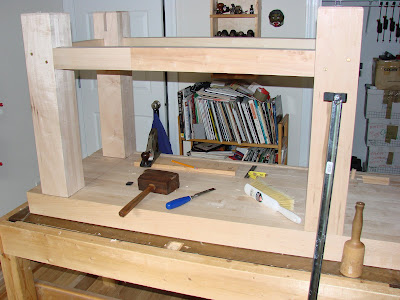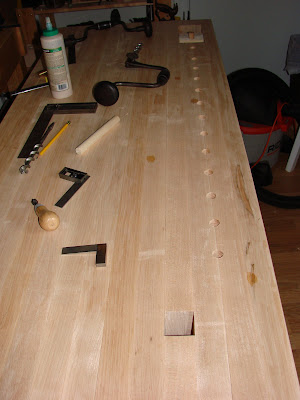In my haste to get the top onto the legs, I noticed that I had neglected a few small gaps that could have been better in the fit of the legs to the top. So, I flipped the bench back onto my old bench and began the fiddling. (or fettling, but there's a fine line between fettling and messing things up, so I prefer to fiddle around and do a little too little than go over the line and do too much.)

I was mainly worrying about trying to get the top to sit more closely to the shoulders of the tenons on the ends of the legs. It's not perfect, but it is better than it was, and the outside lines are better.
While I had the bench turned upside down, I took the base off again and did some final smoothing of the legs that had either been neglected, or at least short changed in my excitement to get it together. I think this is part of the phenomenon of having only a few hours each week in the shop. I am so anxious for it to look like something that I often cut some essential corners to get to a more tangible stage. Well, that was part of what last weekend was all about. I popped out the brass pins, and all but one came out quite easily and smoothly. I then smoothed down the legs and stretchers to make everything as co-planer as possible.
It worked pretty good. I was a little surprised by one piece of wood on one of the short stretchers. It was significantly different than the others. It was more splintery, was less prone to a smooth finish and overall behaved much less well than the rest of the maple. It looks like maple, and may well be maple, but it's from a cursed tree. I'm glad it's only a short stretcher.

While I had the bench top on my old bench, I thought I'd try and do some more smoothing of the top. I got out my big 'ol Knight razee joiner and went to work coming down the top with the grain to take out the scallops from transversing the top.

You can see the scallops along the top of the bench, with the smooth side closest to the photographer. This plane works quite well, and I was both pushing and pulling as I worked across the bench top. I can only imagine what it must be like to do this with an 8-foot bench.
This weekend I started to put holes into my beautiful bench top. I wanted a template of some kind, and decided to use my oh-so-awfully-used bench hook. I made myself a nice maple one from scraps and then took my old pine one and drilled the holes to match the spacing for my bench.

I tried experiments with my jennings #12 and my two Irwin #12's. One of the Irwin bits cut a much smoother hole (I'll have to check the cutters on the others later) and so I used that one. I first positioned the first hole in the chop of my wagon vise and put a brass dog in it since that hole is a little larger than 3/4". (see my earlier posting about making it with a #13). I clamped a piece of scrap under the bench to help avoid tearout. I know it won't be shown, but I've seen some amazingly spectacular tearout before and I didn't want that, even on the bottom of my bench. It worked as well.

The 10" sweep of my brace was absolutely necessary and I made sure my bit was sharp and waxed. Even so, this was hard work.

I bored out the first hole, and as I was getting to the bottom I realized that it was going to come out right into the leg. Not good. I had placed the holes in my old bench hook so that I was not able to get a hole past the leg with my current configuration. Look at the picture above and see that the left-most hole is still not completely past the leg.
I solved this by boring another hole in the bench hook. You can see it to the far right in the picture below. I then put a dog in there and through the wagon vise chop, adjusted the vise to put the hole as close to the leg as I was comfortable, and then bored away.

For each hole I would use two squares to line up the brace and bit as perpendicular as possible. After each hole I would hold up an old candle to the screw, cutters and flutes. The heat of the bit would melt a nice trail of wax down the bit. I would also usually get a nice plug of wood down by the end of the bit every time. You can see this in the picture below along with the rather course screw pitch of the bit. Despite this being so corse, it worked better in this hard maple than the fine pitched Irwin I tried. You can't always take what the old guys say for granted. Sometimes you've got to just try it and see.

I eventually worked my way down my bench. I wondered where to end the holes, and after looking at some pictures, and thinking about it a bit during a rest break, I decided to end them just shy of where my leg vise will come. If I need some holding point after this point along my bench top, I can clamp a planing stop in my leg vise. You can see some drops of sweat on the bench top. That's some honest work there. A lucky 13 3/4" holes through 4 inches of hard maple.
You can see two braces on the bench top. The other one is a smaller, 8" sweep Fray-made Spofford brace that I used a couple of times to come at the hole from the bottom when I stopped too soon, or the bit wouldn't bite anymore once it broke through. I couldn't fit the 10" sweep brace between the bottom and the front stretcher, it was too long. The 8" Fray is my favorite all-around brace anyway. I rarely need ratcheting, and it's as stable as it gets. The sweep was just too small for this big job.

You can see the Spofford chuck in the picture below. I had originally drilled the holes in my bench hook with this brace, I said it was my standard brace, but then I realized that the picture seemed to indicate that was to be boring the holes in the bench with this brace, and I switched the bit to the real brace.

For full tool disclosure I went and checked to make sure of what I used.
Big brace. No markings other than "No. 120". Wooden handle with pewter rings, two-jaw chuck.
Small brace. Marked "Fray No. 110" Don't know if this means a 10" brace. I may be underestimating my brace sizes. It is definitely smaller than the other one.
Bit is a Greenlee, Irwin-style, #12 bit.
Oh, and one square was a cheapy engineers square, the other is a great little 4" Union Tool sliding square I just bought from Bob Rozaieski over at Logan Cabinet Shoppe. It's in perfect condition and well compliments my 12" Union Tool carpenter square, but much cuter.
I've now ordered my holdfasts from Tools for Working Wood and will figure out my hold-fast holes based on the hold fasts. I tried out my cheapy cast holdfast I was using in my thinner bench. It just won't work at all in my new one. Darned, I need new holdfasts. What a tragedy.
Next time I am going to use my wagon vise and dog holes to start to make my leg vise. Once I get that done, then all I have left is to make the plane stop, put a basic oil finish on it, and I'll have a brand new bench!
It's beginning to look a lot like a bench!
AAAndrew

I need one of those 10" sweep braces! Mine is only 5" and I about turned off my arm drilling the dog holes this weekend. I ended up using the drill press to go halfway then finished with the brace and bit. That's hard work!
ReplyDeleteIt is definitely hard work, even with the larger sweep brace. Of course, trying to manhandle my workbench top into a drill press would have been a whole lot like work as well. I can't wait to bore the 1.25" hole through the five-inch leg for my leg vise. Weeee!
ReplyDeleteGreat blog! Just got caught up. Looks like the bench is coming along quite nicely. Cannot wait to see the leg vise install.
ReplyDeleteI am setting up a "tailless" shop myself. First project is to build a proper bench. I have accrued all the old Stanley "user" planes I need (may swap the blades out for Hocks), a few Japanese saws, many books and soon a set of decent chisels. I don't have an bench yet, so it may be sawhorses and beams for now.
-Scott
One question: Is the Knight Scrub plane the only wooden plane you own/use? How would you compare wooden planes to cast iron? Too fussy? I have contemplated purchasing a wooden plane (or plane kit), not sure...
Thanks, Scott.
ReplyDeleteThings have slowed down the last couple of weeks, but will pick up again soon. I hope to have the leg vise shaped and mounted by the end of June.
Actually, the scrub plane is a wooden german one. My two Knight planes are a jack and a joiner. I really like wooden planes and just need to get a bit better at fixing up the few that I have. Even the Knight jack plane seems to need a touch up to the sole. I've used it a lot.
I would love to get a full set of Clark and Williams planes. They are some of the best-made wooden planes, ever. They are also not cheap, but worth it if you're going to buy one. (no relationship, just pure tool lust)
I also love my Hock blade in my 1940's Craftsman (Miller Falls) #6. Well worth the investment.
Good luck. Do you have The Schwartz's wookbench book yet? You shouldn't think about making a bench without it, even if you don't make one of the patterns he describes, it will help you figure out just what you do want.
Let me know how it turns out!
AAAndrew
Dude! I just found your blog through the Renaissance Woodworker. I'm a neanderthal woodworker looking to build a Roubo, so I'm happy to have found you. I haven't even read this post yet, much less any of the others, but just wanted to let you know I was here. I'll start at the beginning and comment along the way!
ReplyDeleteEric
Welcome, Eric.
ReplyDeleteI write this really to just record what I've done and what I've learned. It's my shop journal. But I'm happy if others can enjoy it as well, and/or learn something from my mistakes or rare insights.
If you have any questions, please feel free to comment. I'd be glad to answer them if I can.
AAAndrew
Hi Andrew, when are you planing on being back on your blog? I'm sure a lot of people are asking themself the question! Is every thing allright?
ReplyDeleteHoppe you write something soon!
David